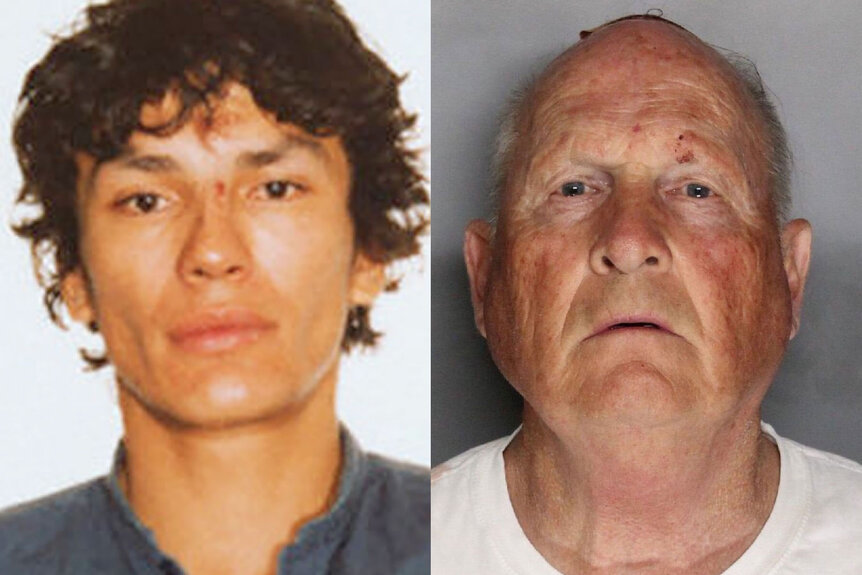Create a free profile to get unlimited access to exclusive videos, breaking news, sweepstakes, and more!
What Makes Serial Killer Monikers Like ‘Night Stalker’ Stick And How Do Murderers Get Such Nicknames?
Richard Ramirez was given several monikers by the media before "Night Stalker" stuck. According to serial killer experts, that comes down to branding.

The monikers ascribed to history’s most notorious serial killers can cast an ominous shadow over these men in the public’s mind. These nicknames — “The Golden State Killer,” “Jack the Ripper,” “Boston Strangler,” “Night Stalker” — often lead the public to envision these killers as monsters who stalk victims like a mysterious cloud of smoke — particularly if they have yet to be identified. But, how are these ominous nicknames determined? And what does the widespread use of these monikers reflect about Western society?
Netflix’s new docuseries “Night Stalker: The Hunt for a Serial Killer” dives into the creation of the alias given to Richard Ramirez, who began stalking Los Angeles County in 1984, breaking into homes and committing a wide array of vicious crimes. The so-called “Night Stalker” would beat, molest, rape, and sometimes murder his victims in a manner that seemingly had no through line. Not only did he vary his weapon of choice — guns, knives, and blunt objects were used — but the victim profile was all over the place. They varied in gender and race and ranged in age from 6 years old to 82.
Once detectives were able to pin all of the seemingly disparate crimes on one suspect, much of Los Angeles County went into a panic. Who would he attack next — and how? As fear increased, the media clamored to find the proper name for the man stalking the region.
“Journalists wanted to give this unknown monster a name,” Laurel Erickson, a reporter at Los Angeles news station KNBC, told the producers of the new docuseries.
Ramirez was originally dubbed “The Walk-In Killer” by KNBC. Then, the moniker “The Valley Intruder” gained some traction. But the names just weren’t sticking. It was when The Herald-Examiner dubbed him “The Night Stalker,” that Ramirez’s identity was solidified in the media.
Paul Skolnick, a producer at KNBC, explains in the docuseries that the Examiner’s creation “was the branding that stuck.” But why exactly does a name stick with the press and the public?
Dr. Scott Bonn, author and criminologist, told Oxygen.com that this particular nickname resonated with the public because the term “really nailed what he was.”
“Does it really capture the essence of this individual and what they are doing, and is it packaged in a slick way?” Bonn asked rhetorically. For Ramirez in 1984, the “Night Stalker” moniker did just that.
“He was a thrill-killer, who randomly picked homes and broke in,” Bonn explained. “For him, it was a treasure hunt. ‘Night Stalker’ really identified his M.O. [modus operandi], the way he operated.”
Bonn echoed Skolnick’s sentiment that the name was a form of branding.
“It’s essentially advertising, it’s promotion,” Bonn said of our culture’s tendency to give killers such monikers.
Serial killer expert and author Peter Vronsky agrees.
"How a moniker sticks often is similar to how a brand name sticks — the more papers the moniker sells, the higher the TV ratings it gets, the more likely it becomes the chosen moniker," he told Oxygen.com.
Given their experience with headlining and framing news stories, it’s not surprising that members of the media play a role in the naming process. A 2011 Slate piece notes that it’s typically members of the press that come up with such sticky monikers.
“It [the naming process] has nothing to do with the meat of the case,” Vronsky told Oxygen.com. “It has to do with gaining traction with the audience, so part of the packaging and promotion process is giving these individuals their names.”
In a 2017 Psychology Today article he authored, Bonn says he believes that the media has a “vested interest” in scaring the public by hyping up such killers, thus turning them into "celebrity monsters."
"The crime news coverage of so-called monsters is typically stylized and exaggerated in order to entice a wide public audience," he wrote. "Journalistic hyperbole makes them appear to be much more threatening to society than they actually are. [...] It must be remembered that the entertainment news media have a vested interest in tantalizing and even scaring the public. Sensationalized news content attracts a wide audience and a large audience attracts highly coveted advertising revenue."
He explained that inflammatory descriptions like "evil" and "devil," as well as nicknames, can create a supernatural aura around a killer.
"The news media blur the distinction between reality and fiction and obscure the truth about serial homicide when they turn the killers into stylized and cartoonish super predators," Bonn wrote.
The Slate article notes that media outlets have the tendency to throw several monikers out to the public mind before one takes.
For example, before the “Long Island Serial Killer” moniker was attached to that elusive killer’s identity, media outlets publicly brainstormed. The New York Post gave “Long Island Ripper” a shot and the New York Daily News came up with “Seashore Serial Killer.” The Atlantic reported in 2011 that the New York Post newsroom was filled with frustration as they worked to find a catchy moniker for the unknown murderer, who has yet to be caught.
A catchy moniker can also override past nicknames. Joseph DeAngelo’s crimes were originally attributed to regional monikers — “East Area Rapist,” “Visalia Ransacker,” as well as “Original Night Stalker.” However, his identity became solidified in 2013 after true crime author Michelle McNamara branded him as the “Golden State Killer'' in a wildly successful 2013 long-form article for Los Angeles Magazine. The name was more accepted — and appropriate — because it incorporated the entire geography of his crimes, which were previously unlinked.
Bonn said that a portion of, but certainly not all, serial killers are aware of the media’s desire to attach monikers to them. But many serial killers would rather stay under the radar so they can just continue to kill without focused attention. Not all seek out notoriety, but all are driven by their urge to kill.
Vronsky noted that the "more intelligent and proficient serial killers [...] attempt to ensure that police do not connect their murders to each other and assiduously avoid any contact or 'fame.'"
Others actively seek to brand themselves, such as the "Zodiac Killer" and the "BTK Killer," Vronsky said.
"The most famous granddaddy of moniker-serial killers was 'Jack the Ripper' in 1888," he said. "The press adopted that moniker from what was alleged to be a letter from the perpetrator."
In that letter, the author signed it "Jack the Ripper" then added "Dont [sic] mind me giving the trade name."
While that letter has never been authenticated, other killers took notice, according to Vronsky.
"It is just as plausible that some ambitious newspaper reporter or editor concocted the letter to sell more papers and ‘sauce up’ the story," he said. "Whether authentic or not, the 'Jack the Ripper' letters taunting police and news media (along with allegations that he left graffiti at one of his crime scenes) became a role model and inspiration for future serial killers. [...] A lot of serial killers thought that what 'Jack the Ripper' was alleged to have written to police and press is what serial killers do."
He noted that "Son of Sam" killer David Berkowitz and Dennis Rader, known as the "BTK Killer," seemed particularly influenced by the “Jack the Ripper” letter, as their own correspondence with press revealed.
Whether they seek out notoriety or not, the naming can feed killers' egos.
"Certain categories of serial killers seek power and control over the press, the police, and the community, through letter writing and monikers," Vronsky said. "Others, who might not have necessarily contacted the police or press, feel empowered and in charge and take pride in the moniker the press gives them."
Bonn told Oxygen.com that crowning a serial killer with such a name is “part of the process of turning these killers into larger-than-life pop culture ghouls.”
Whether self-made or media-made, Bonn said that monikers can do an “injustice to the victims and the victims’ families by making these individuals ‘celebrity monsters’” and by “giving them just an undue amount of attention.”
This notoriety can make them larger than life, he added, even though their violent acts make up a fraction of violence seen across society.
“Serial killers are not responsible in any given year for more than 1% of all homicides and yet by the amount of attention that we give to them, you would think that serial killers are responsible for 50% of all crimes out there,” he said. “It’s not the case. They just get the lion’s share of notoriety."
"Night Stalker: The Hunt for A Serial Killer" premieres on Netflix Wednesday.



























